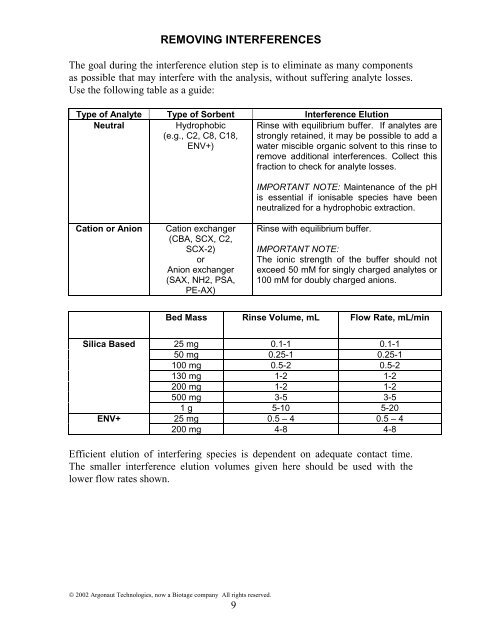Method-Development
You also want an ePaper? Increase the reach of your titles
YUMPU automatically turns print PDFs into web optimized ePapers that Google loves.
REMOVING INTERFERENCES<br />
The goal during the interference elution step is to eliminate as many components<br />
as possible that may interfere with the analysis, without suffering analyte losses.<br />
Use the following table as a guide:<br />
Type of Analyte Type of Sorbent Interference Elution<br />
Neutral<br />
Hydrophobic<br />
(e.g., C2, C8, C18,<br />
ENV+)<br />
Rinse with equilibrium buffer. If analytes are<br />
strongly retained, it may be possible to add a<br />
water miscible organic solvent to this rinse to<br />
remove additional interferences. Collect this<br />
fraction to check for analyte losses.<br />
IMPORTANT NOTE: Maintenance of the pH<br />
is essential if ionisable species have been<br />
neutralized for a hydrophobic extraction.<br />
Cation or Anion<br />
Cation exchanger<br />
(CBA, SCX, C2,<br />
SCX-2)<br />
or<br />
Anion exchanger<br />
(SAX, NH2, PSA,<br />
PE-AX)<br />
Rinse with equilibrium buffer.<br />
IMPORTANT NOTE:<br />
The ionic strength of the buffer should not<br />
exceed 50 mM for singly charged analytes or<br />
100 mM for doubly charged anions.<br />
Bed Mass Rinse Volume, mL Flow Rate, mL/min<br />
Silica Based<br />
ENV+<br />
25 mg 0.1-1 0.1-1<br />
50 mg 0.25-1 0.25-1<br />
100 mg 0.5-2 0.5-2<br />
130 mg 1-2 1-2<br />
200 mg 1-2 1-2<br />
500 mg 3-5 3-5<br />
1 g 5-10 5-20<br />
25 mg 0.5 – 4 0.5 – 4<br />
200 mg 4-8 4-8<br />
Efficient elution of interfering species is dependent on adequate contact time.<br />
The smaller interference elution volumes given here should be used with the<br />
lower flow rates shown.<br />
© 2002 Argonaut Technologies, now a Biotage company All rights reserved.<br />
9




